Grand Phoenix 1/48 McDonnell F3H-2N Demon
On May 21, 1948, the United States Navy issued a "Request for Proposal" to build a carrier-based jet day fighter. The Navy wanted an aircraft of equal or superior performance to the land-based jet fighters being built at that time. The jet engine the Navy chose to power this aircraft was the Westinghouse afterburner-equipped J40 turbojet which was expected to provide twice the thrust of any engine then in Navy service. Eleven companies responded to the RFP and competed for the contract.
The response of the McDonnell Aircraft Corporation of St. Louis - builder of two of the Navy's first three operational jet fighters, the FH-1 “Phantom” and F2H “Banshee” - was the F3H “Demon,” the first swept-wing jet fighter and the only single-engine carrier-based fighter built by the company. The proposal was chosen by the Navy in January 1949. That July, the Navy inspected a mockup of the XF3H-1 which resulted in some redesign to lower the predicted gross weight and two XF3H-1 prototypes were ordered on September 30, 1949. After the prototypes entered construction, the Navy decided it wanted the production aircraft to be an all-weather fighter, designated the F3H-1N. The mockup was modified to incorporate the changes directed by the Navy and was inspected again in July, 1951. The design changes resulted in a major delay in the program, although the XF3H-1 prototypes were not affected since they were to be used to conduct aerodynamic tests. The XF3H-1 prototype made its first flight on August 7, 1951.
The appearance of the MiG-15 in Korea resulted in a hasty order to put the F3H-1N in production despite the fact the XF3H-1 had yet make its first flight. To speed production, the Navy awarded a contract to the Temco Aircraft Corp. for 100 Demons under license from McDonnell. This ill-conceived, hasty decision was to have disastrous results.
The afterburner-equipped version of the Westinghouse J40-WE-8 was not available to install in the prototypes at this time, so the non-afterburner J40-WE-6 was installed in its place. Many problems plagued the testing program. The J40 proved unreliable and the first prototype was damaged during a dead-stick landing caused by engine failure in August 1952; shortly th4ereafter, both prototypes were grounded because of engine problems. Other problems revealed during testing included poor forward visibility, slow roll rate, and poor lateral stability. The nose section was redesigned to deal with the visibility problem and the ailerons were moved further inboard to solve the roll rate problem, while wing fences were fitted on the outboard wing panel to improve lateral stability. A 10,500 lb. static thrust afterburning J40-WE-8 was installed in the second prototype in January 1953; the engine was no more reliable than the WE-6.
Preliminary flight evaluation at the Naval Air Test Center Patuxent, Maryland were conducted in August 1953. In October the second XF3H-1 was used for initial carrier landing evaluation flights aboard USS “Coral Sea” (CVA-43). The first prototype crashed after the engine exploded on March 18, 1954, which resulted in the second prototype being grounded; eventually it was shipped to the Naval Air Development Center at Johnsville, Pennsylvania, where it was used for barricade engagement tests.
The F3H-1N differed from the prototype by having the ailerons moved inboard to mid-trailing edge, while the radome and cockpit where angled down five degrees to alleviate the forward visibility problem during carrier landings. The main fuel tank size was increased by 378 gallons. The APG-30 radar and four 20mm cannon were installed. Mounting the 20mm cannon just below the air intakes would cause significant problems later.
The first production F3H-1N, BuNo. 133489, first flew on December 24, 1953. The F3H-1N was initially powered by the J40-WE-8 turbojet engine with the J40-WE-22 planned for installation in the production aircraft. The Navy knew that the aircraft was grossly underpowered with this engine and planned to replace it with J40-WE-24. By September 1953, the Navy realized Westinghouse was not going to produce the WE-24 and that they were stuck with the WE-22.
Late delivery of J40-WE-22 engines slowed the F3H-1N production line to a crawl. Eleven accidents, some fatal, over several days got the attention of the press, which complained loudly about how the Navy was spending a lot of money to acquire an aircraft whose greatest accomplishment seemed to be killing its own pilots. The F3H-1N was a dangerous aircraft to fly and was hated by its pilots. In the face of this, the F3H-1N set an unofficial time-to-climb to record of climbing to 10,000 feet in 71 seconds.
By 1952 McDonnell, fearing that the grossly underpowered J40 engine might be the stake through the heart of the F3H Demon program, asked for and received permission from an initially reluctant Bureau of Aeronautics to consider other powerplants. BuAer hesitated at first because the J40 had been designated as the powerplant in almost all the aircraft programs currently in development; McDonnell was authorized to conduct a feasibility study of fitting the F3H with the Allison J71 afterburning turbojet.
Finally facing the fact that there was no way to solve the J40 problems, the Navy halted production of the F3H-1N after the 58th aircraft and canceled Temco's contract before a single aircraft was built. In July 1955 all F3H-1Ns were grounded and the Navy had to face growing congressional upset over the $200 million expended on the F3H-1N and its ill-fated engine. Worse was the humiliation of barging F3H-1Ns from St. Louis to Memphis, where they were towed to the Naval Air Station for maintenance training, while F3H-1Ns at Patuxent River were sent to Norfolk for the same purpose.
The failure of the J40 forced Westinghouse to close its jet engine manufacturing division. The future of McDonnell looked grim but the company survived by building the F3H-2 Demon, fitted with the Allison J71 engine. This version was designated the F3H-2N. In August 1953 BuAer inspected a mockup and in November 1953 amended the contract to fit the 32nd and 34th F3H-1N aircraft with Allison J71 prototypes. A following amendment called for the 61st and all subsequent Demons to be fitted with the J71.
The J71 was heavier than the J40; this increased weight plus the increase from making the Demon an all-weather fighter forced changes in the airframe, with wing area increased by 77 square feet by lengthening the wing chord by 40 inches at the root, moving the trailing edge back.
On April 23, 1955, the first F3H-2N prototype, BuNo 133520 flew at Lambert Field and the first production F3H-2N flew in June of 1955. McDonnell delivered 140 production F3H aircraft powered by the Allison J71-A2. The A2 engine provided 10,000 lbs. of thrust at full military power and 14,400 lbs. in afterburner. The A-2 was later replaced by A-2A or A-2B versions of the engine. The airframe was a good design that provided excellent maneuverability in air combat situations at altitude; many involved in the program thought the airplane would have been completely successful had it been powered by the superb J57 with afterburner, which would have provided an additional 2,500 pounds of thrust in afterburner without the weight penalty of the J71, and made the Demon fully supersonic rather than barely transonic.
The last F3H-2 Demon was delivered on April 8, 1960. The total number of production aircraft built and delivered was 519.
During its service, the Demon was largely unloved by its pilots. The fact it was underpowered in takeoff and landing configuration - the two most dangerous points of carrier-based operations - and did not have a zero-zero-ejection seat meant the pilots took off and landed with the canopy open in order to maximize their chance of survival in a crash. Several aircraft were lost when flown into icing conditions, which led to shutdown of the engine when ice was ingested. As a result, the Demon was prohibited from flying into known icing conditions, a serious restriction for an airplane that was supposed to be an all-weather interceptor.
On March 7, 1956, VF-14 “Tophatters” at NAS Cecil Field Florida received the first operational F3H-2Ns and flew the aircraft from USS Forrestal (CVA-59) during a Mediterranean deployment in January to July 1957. On September 2 1956, the second-day of the National Air Show, Lt(jg) Richard Carson, flying an F3H-2N Demon of VF-124, captured the McDonnell Trophy with a nonstop, non-refueled flight from the carrier U.S.S. “Shangri-la” cruising off San Francisco to Oklahoma City. He covered the 1,436 miles in 2 hours, 32 minutes, 13.45 seconds, for an average speed of 566.007 m.p.h.
22 squadrons were eventually equipped with the Demon, and it was flown in combat situations over Lebanon in the summer of 1958 and over the Formosa Straits during the Quemoy-Matsu crisis later that year. The last squadron equipped with the Demon was VF-161 at NAS Miramar, California. CO CDR Wayne Welty flew the last Demon from Miramar to NAF Litchfield Park on September 21, 1964.
The Grand Phoenix kit is long out of production, though it can be found. Unlike their FJ-4 kit, which has a list of problems ten miles long, this kit is accurate and eminently buildable. Decals include the VF-124 McDonnell Trophy winner, which I used here.
Hobby Boss largely copied this kit for their injection-molded kit, which can be found if you look around. Since this time they copied from the best (unlike copying from the worst as they did when they created their FJ-4 and FJ-4B kits using the GP abomination) it is a good kit.
It's too bad the Navy didn't let McDonnell re-engine the Demon with the wonderful J-57 with an afterburner. Had they done so, the airplane would have been such a success there might not have been an F-4.
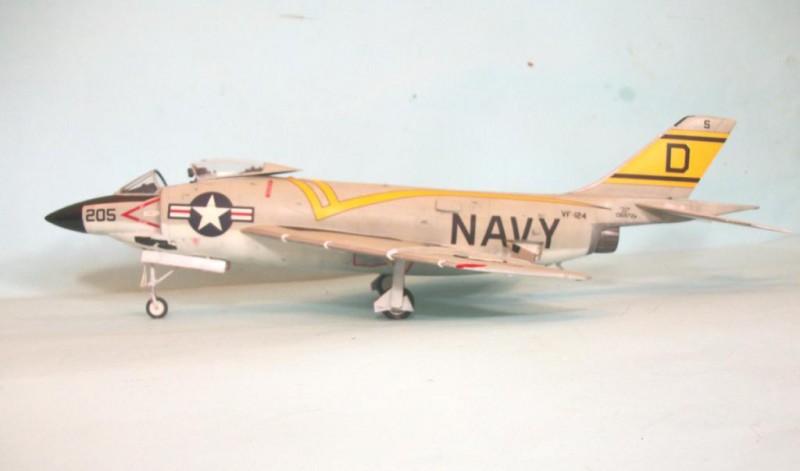
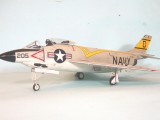

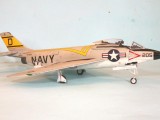
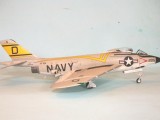
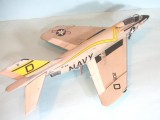
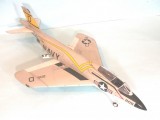

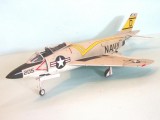

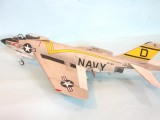
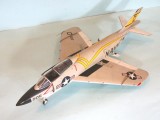
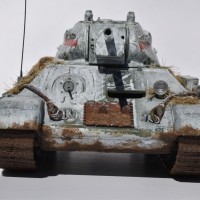
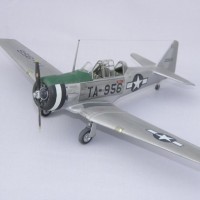

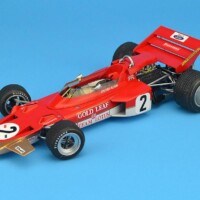
I had no idea this jet had ever existed, everyday is a school day. Thanks for the article Tom, most educational and compliments also on the quality of the build!
Hello Tom...Nice job on the Demon. Any chance of seeing a cockpit shot? I have that kit in my stash and am delighted to see your completed model. Good write up too on the Demon lineage.
If you want to see shots of the kit cockpit, check out Scott Van Aken's review of building the model here:
http://modelingmadness.com/scott/korean/us/48f3h.htm
Good looking build Tom. After reading about the aircrafts failings & problems the name Demon seems very appropriate.
Nice Clean Build,
J-57 nothin'! I wanna know what it would've been like with a J-79! How did you tackle the fore/aft fuselage assembly. Did you put both forward halves together and close the rear around that, or did you build it into two assemblies joined later. I have the same kit and I'm wondering which way I'm gonna go with it.
The plane turned out pretty sweet and looks great clean with no stores (not like you have much choice OOB) Also the colorful Navy schemes are a lot of fun!
I always completely assemble fuselage halves, so that I can work on any joints from inside and outside.
Great article and a very nice looking build.
Anyone care to purchase an HB FJ-4?...
I don't want to rain on your parade with selling that kit, but I am actually in the middle of doing it. As I mentioned above, HB has a habit of looking to see what others have done with any proposed kit, and frequently copying it. As I said about the Demon, their Demon is good since it is based on this kit. And their FJ-4 is bad, since it copies the GP FJ-4, and has all its faults save general fit and buildability. It has all the dimensional problems of the Grand Phoenix kit. It goes together well, unlike the GP kit (which is admittedly a limited run Eastern European kit from around 11-12 years ago), and does so better if you hang all the doors and dive brakes open. If you want to close it up like most FJ-4s are seen, that becomes problematic - I ended up using lots of thick Mr. Surfacer to get everything nice and smooth once buttoned up.
The FJ-4 kit is really the FJ-4B kit with different decals. You need to fill and sand off the lower rear dive brakes, which are an FJ-4B feature. Also no inboard pylons or refueling probe (which isn't in the kit but you need to fill the holes in the lower wing) The FJ-4 did not carry Bullpups, so if you want underwing ordnance you can have the drop tanks and the Sidewinder on the outer pylon though the one in the kit is the wrong generation to be on an FJ-4.
As with most HB kits, it's kinda-mostly-sorta accurate. The ony FJ-4 kit that is dimensionally accurate is the old Matchbox kit, which has its own problems otherwise (though it has the best decal sheet of any FJ-4 kit).
Whatever, it's certainly a nice looking plane, those US navy schemes always look good.
Nice clean build. The jets of the 1950's were beautiful to look at but almost all had some type of initial problem at the start of their run. Thanks Tom for the great narrative, a great construct!
Tom,
Excellently done. I had this kit for a while and got rid of it. I was going to build it but I had an offer for it that I could not refuse. I did pick up the HB kit and may do it someday. I am really not a fan of this airplane but I would like to build it for a specific reason.
I was aboard Bon Homme Richard from early 1957 to late 1958. On board were a number of aircraft that are now obsolete, F4D, FJ-3, A3D, F7U, and at one brief period the F3H. An F3H squadron came aboard for carrier training at some point after we returned from WestPac. I cannot remember the exact dates they were aboard nor can I recall the squadron number. I have tried to research this but I have not been able to find this information. I believe it to be in the early months of 1958 and we were off the California coast. Nevertheless, during the time they were aboard, one of the Demons came in to land and was too low. The aircraft went directly into the fantail killing the pilot and a number of sailors in the fantail area. Plus it did major damage to the ship and the gun-mounts on the fantail. We eventually went to Bremerton for repair and additional ship overhaul. I would like to find out more of exactly what occurred and what I have minimal remembrance of. Perhaps you may be aware of this through you vast research or may know where to find further documentation of this incident. Just thought I would pass this along.
Not sure of the squadron, Frank. If you're on Fold3, you might find it there. If you decide to get rid of the HB kit, please do let me know.
nicely done...Scots also...still dying to hear the wail of the banshee from kittyhawk